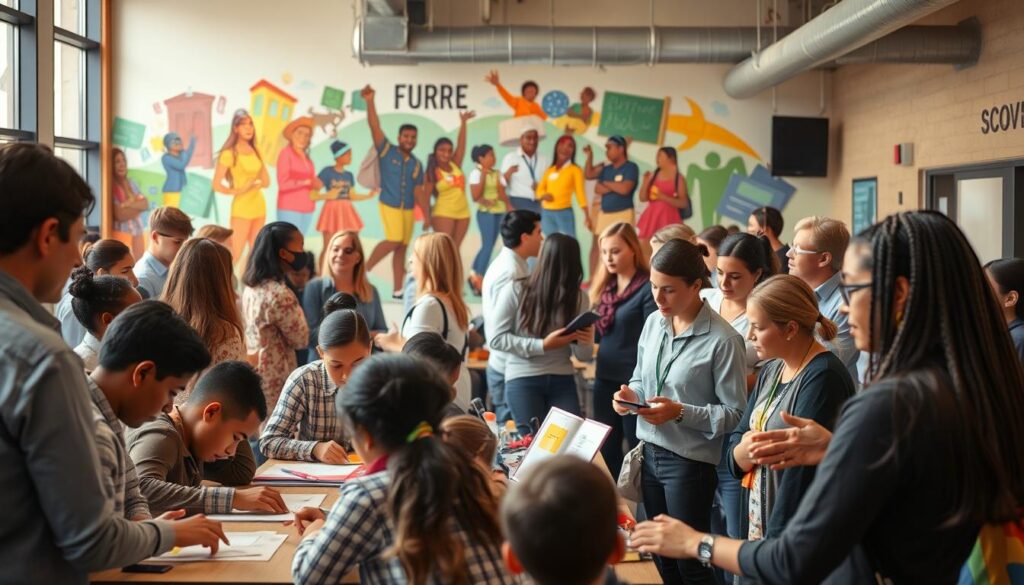Anúncios
Have you ever wondered if school really prepares us for work? The transition from school to the job market in 2026 is crucial. It requires attention, as the world of work changes very quickly.
In this article, we will discuss this transition. We will see why it’s important to develop skills beyond what is taught in school. Students need to learn socio-emotional skills and financial literacy, preparing them for a constantly changing workplace.
Anúncios
We will also explore how education can open doors to a better professional future. Let’s dive in.
The Educational Landscape in 2026
The educational landscape in 2026 will change significantly due to technology and new teaching methods. Schools will need to update curricula to follow educational trends.
Teachers will need to continually update their knowledge. Learning new teaching practices will help them prepare students for the future.
Anúncios
Students of the future must know how to work with others and adapt quickly to the job market. The focus will be on preparing young people for real-world challenges, not just technical skills.
Schools are expected to become more inclusive and diverse, ensuring equal opportunities for all. The goal is meaningful and practical learning.
The Importance of Continuing Education for Teachers
Continuing education is essential for quality teaching. It keeps teachers informed about new techniques and encourages reflection on their own practices, making classes more engaging and relevant.
This professional development helps teachers grow and adopt frameworks like the National Common Curricular Base (BNCC), which standardizes education quality across Brazil.
With the aid of technology, teachers can create a more dynamic learning environment. Continuing education benefits both teachers and students, preparing them for future challenges.
Essential Competencies for Transitioning to the Job Market
For students to succeed in the transition from school to work, it is crucial to develop job-market competencies. Socio-emotional skills are essential, helping students navigate dynamic professional environments.
Developing Socio-Emotional Skills
Socio-emotional skills include empathy, resilience, and teamwork. Employers highly value these qualities. Cultivating these skills prepares students for professional challenges and improves interpersonal and professional interactions.As habilidades socioemocionais incluem empatia, resiliência e trabalho em equipe. Empregadores valorizam muito essas qualidades. Cultivar essas habilidades prepara os estudantes para os desafios do mercado de trabalho.
Financial Literacy as Part of the Curriculum
Financial literacy is a key component of youth education. Integrating it into the curriculum helps students make informed financial decisions and plan their future sustainably.
They will be prepared to face challenges responsibly and consciously.
School-to-Work Transition in 2026: Challenges
The transition to the job market in 2026 presents several challenges. Students need to adapt to new market demands, including practical skills and the ability to collaborate with others.
A major challenge is resistance to curriculum changes. Traditional teaching methods still dominate, often leaving students unprepared for modern work environments. Supporting teachers to adopt new techniques is essential.
Schools, families, and businesses must work together. Collaboration creates an environment that favors students’ transition to work. Sharing information and resources strengthens partnerships and improves student skills.
The Role of Technology in Future Education
Technology will transform education in the coming years, changing how people learn. Digital tools make learning more engaging and accessible.
Integration of Digital Tools in Learning
Digital tools provide many resources in the classroom. Interactive platforms and apps help teachers and students communicate more effectively, making learning fun and efficient.
Metaverse and New Teaching Methodologies
The metaverse is a major innovation in education, offering students unique learning experiences. These new methods make content more engaging and easier to retain.
Social Programs and Strategic Partnerships
Integrating social programs with educational partnerships greatly improves learning. When NGOs and businesses collaborate with schools, students gain access to resources that enhance both academic and professional development.
Cross-Sector Collaboration to Promote Education
Strategic partnerships strengthen the educational system. Collaboration between schools and private organizations enriches learning. Programs offering mentorship and internships are excellent examples.
These initiatives address community needs and help integrate young people into the workforce.
Programs Supporting Student Retention
Programs that help students stay in school are very important. They reduce dropout rates and ensure better futures. Support can include psychological assistance, scholarships, and extracurricular activities that create a welcoming environment.
Financial education programs are one example, teaching students to make conscious decisions. The combined efforts of different sectors demonstrate a commitment to quality education.

The Importance of Developing Interdisciplinary Projects
Interdisciplinary projects are essential in education. They help students prepare for the challenges of the 21st century, improving skills such as critical thinking, creativity, and problem-solving.
These projects make school an active learning environment. Students become the main actors in their education. They learn to approach complex topics more comprehensively, developing important skills.
For these projects to succeed, teacher training is crucial. Educators must know how to integrate these projects into the curriculum, shifting from traditional teaching to a more dynamic approach that is relevant to the job market.
| Aspect | Benefits |
|---|---|
| Stimulates creativity | Develops innovative solutions to real-world problems |
| Integrates multiple disciplines | Provides a broad and contextualized view of learning |
| Strengthens teamwork | Fosters collaboration and communication among students |
| Promotes active learning | Encourages curiosity and engagement |
Strategies to Improve Student Experience During the Transition
The transition from school to work should be enriching. Strategies focused on this process can greatly enhance student experience. Offering practical opportunities, such as mentorships and internships, is essential.
These opportunities allow students to apply theory in practice, preparing them for future challenges.
Mentorships and Internships as Real Opportunities
Mentorships provide valuable support by connecting students with experienced professionals who can guide career decisions.
Mentorship improves student experience and develops essential skills. Internships offer a unique opportunity to experience the day-to-day of a profession, learning skills not taught in classrooms.
Educational institutions should partner with companies to provide real internships, benefiting both students and businesses. Combining mentorship and internships is a powerful strategy.

| Mentorship Benefits | Internship Benefits |
|---|---|
| Career guidance | Practical learning |
| Networking development | Workplace experience |
| Emotional support | Application of theoretical knowledge |
| Feedback on performance | Potential future employment |
Preparing Students for the Workforce
It is vital to prepare students for employment. Schools should focus on developing skills that enhance employability, beyond traditional subjects.
Key skills include communication, teamwork, and adaptability. Creating a learning environment that mimics the workplace builds confidence and readiness.
- Workshops addressing everyday professional situations
- Interview simulators to familiarize students with selection processes
- Projects encouraging collaborative work and problem-solving
These actions ensure students are aligned with employer needs and are ready for the workforce.
Building a Student Life Plan
It is crucial for students to have a clear life plan. This helps align personal goals with market needs, starting with self-awareness and setting clear objectives.
Using personal planning tools is essential for understanding goals and making professional planning more effective.
Tools for Personal and Professional Planning
Methods like coaching and mind mapping allow students to visualize goals and steps needed to achieve them. Practicing personal development techniques, such as reflection and setting deadlines, enhances their ability to take ownership of their career.
Using these tools consciously significantly improves learning and career preparation.
Conclusion
The transition from school to the workforce in 2026 presents both challenges and opportunities. It begins in the classroom. Addressing these challenges requires collaboration across the education system.
Teachers must update their knowledge and teach essential skills, creating a learning environment that meets labor market demands.
Partnerships between schools, companies, and social organizations are crucial. They enrich curricula and provide practical experiences, easing the transition to work.
Through these partnerships, students develop key skills and are prepared to face future challenges.
Education must evolve quickly to keep up with the world, and this responsibility is shared by all. This is how we can prepare young people for the workforce.
FAQ
What are the main changes in the educational landscape in 2026?
In 2026, education will incorporate more technology and new guidelines, focusing on socio-emotional skills and financial literacy.
Why is continuing education for teachers essential?
Teachers need to continuously update their knowledge to provide better and more engaging instruction.
Which competencies are essential for the transition from school to work?
Essential skills include empathy, resilience, and financial literacy, preparing students for adult life.
How will technology impact education in 2026?
Technology will make learning easier. Digital tools and augmented reality will transform teaching methods.
What is the role of strategic partnerships in education?
Partnerships with NGOs and companies are crucial. They improve education, teach financial skills, and help students stay in school.
How can interdisciplinary projects benefit students?
They develop critical thinking and creativity, preparing students for modern work environments.
What strategies can improve student experience during the transition?
Mentorship programs and internships provide practical experience and help students adapt to the workforce.
How does building a life plan benefit students?
A life plan helps define goals, connecting interests and skills to the professional future, fostering personal growth.




